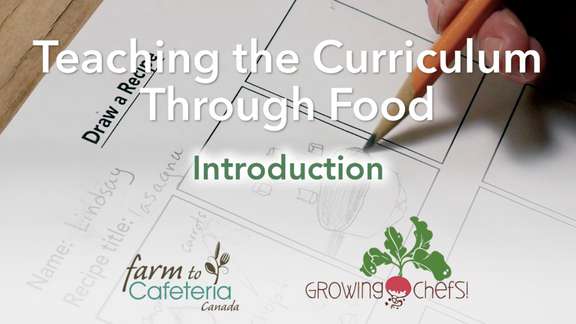Teaching the Curriculum Through Food

Farm to Cafeteria Canada and Growing Chefs! Ontario are proud to share our new Teaching the Curriculum Through Food video series
These short videos have been developed, in a partnership between our two organizations, to support and inform teachers and volunteers across Canada who are looking to bring food literacy into their classrooms and engage students through food. The videos, presented by Growing Chefs! Ontario’s Executive Director Andrew Fleet, are intended to help teachers and volunteers feel inspired, to have more confidence, and to gain ideas to bring food literacy into the classroom and link it to the curriculum. The videos focus on hands-on activities and concepts and are aimed towards Kindergarten – Gr 8 classrooms.
Throughout the series, Andrew will share Growing Chefs! Ontario’s experience with how children learn about and approach new foods, how to best organize cooking activities in the classroom, and how to help children apply concepts that they’ve learned in the classroom to cooking and preparing food.
- Introduction to Teaching the Curriculum Through Food introduces the video series, touches on some of the connections that can be made between food literacy and the curriculum and talks about how to approach food-based activities and learning.
- Connecting Food Literacy with School Curriculumexplains the concept of food literacy and touches on how and where food literacy naturally overlaps with the school curriculum.
En français: Liens Entre la Littératie Alimentaire et le Programme Scolaire
- Taste Like a Chef introduces various techniques and strategies to positively encourage children to try and taste new foods. The 5 videos below build on this topic.
- The Importance of Food Language: how we talk about food details how adults can model good food language to change how children approach, react to and understand food.
- Tasting Strategies for Early Years explores some strategies in how adults can engage young children to try new foods with an emphasis on allowing kids to feel like they are the boss of what’s on their plate.
- Tasting Strategies for Primary and Junior-aged Students illustrates examples of how adults can engage students to try new foods by relating trying new foods to personal experiences.
- Tasting Strategies for Junior and Intermediate Students demonstrates ways adults can encourage and build on students’ pallets by allowing students to act as food critics as a way for them to explore their taste and try new foods.
- Some General Tips for Tasting with Students shares some do’s and don’ts of tasting food with an emphasis on staying positive in how adults and parents talk about food
- Food-themed Activities Without Food or Tasting shares food-focused concepts and activities that can be used to teach the curriculum without bringing any food into the classroom.
- Sensory and Tasting Activities Without In-class Food Preparation explores activities that involve tasting where all preparation is done ahead of time. This video expands on activities that were presented in the Food-themed activities without food or tasting video.
- Strategies for Cooking and Preparing Food in the Classroom explores strategies for preparing food right in the classroom.
- Resource: Working with cooking Tools in your Classroom explains and demonstrates some of the ways students can gain confidence in using cooking tools.